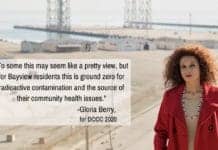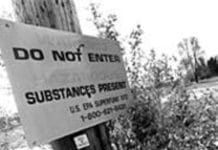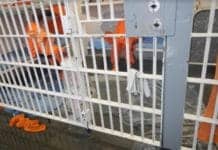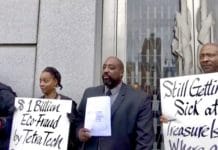
by Paul Hogarth
Superior Court Judge Patrick Mahoney heard oral arguments Monday between activists who gathered over 33,000 signatures to bring the Bayview Hunters Point Redevelopment Plan to a vote and, for the defendants, the judge’s former employer – the City Attorney’s Office.
But while it’s uncertain whether San Francisco voters will have the chance to contest the City’s largest Redevelopment Plan, its consequences are already in full effect. Across the street at City Hall, the Board of Supervisors Land Use Committee passed a resolution endorsing the framework of Lennar’s plan to redevelop Hunters Point Shipyard and Candlestick Point – a plan that would not be possible without making Bayview Hunters Point a Redevelopment Area.
With public testimony that Lennar has already spread asbestos and other toxins into Hunters Point with minimal oversight, giving it exclusive control over a massive project was, to say the least, troubling. But the train has already left the station, and all the Supervisors could ask for at this point was more “community oversight.”
“I was the chief trial attorney in the City Attorney’s Office from 1992 to 2000,” said Judge Mahoney as the Bayview case came up, “and I supported Dennis Herrera’s candidacy for City Attorney in 2001.” But Mahoney would not recuse himself in ruling whether Herrera erred in denying the Bayview referendum from going to the voters, although plaintiffs had requested him to do so.
The case centers around whether petitioners included the entire “text” of the Redevelopment Plan ordinance when they gathered more than 33,000 signatures for the Bayview referendum. While the petitions included copies of what the Board of Supervisors approved, certified by the City Clerk as the ordinance, it did not include all 500 pages of the Redevelopment Plan itself that are referred to in the Ordinance – or the equivalent of two San Francisco phonebooks.
“Putting this out for signatures was understood to be a rejection of the Redevelopment Plan as passed,” said plaintiff attorney Michael Grob. “The Board of Supervisors certified it as full text. If the exhibits were essential, they would have attached it.” Because it is common practice for the City not to attach documents that are incorporated by reference in an ordinance, said Grob, “we should not be prejudiced by it.”
In response, Deputy City Attorney Jonathan Givner argued that plaintiffs did not have to carry all 500 pages of the Plan, but they did have to attach “57 pages” that he deemed essential. But Judge Mahoney asked how anyone seeking to overturn an ordinance could be expected to figure out which documents must be attached to a petition and which are not essential. With an abundance of caution, challenging a Redevelopment Plan by referendum would necessarily require attaching the whole Plan itself.
Mahoney continued the item, giving each side until May 18 to submit a reply brief. Meanwhile, the Bayview Hunters Point Redevelopment Plan is still the law – and Lennar’s exclusive contract to re-mold the Hunters Point Shipyard continues unabated.
Like Halliburton, Lennar is a huge corporation that can pick up massive government contracts because it promises a whole “package deal” of services. It’s a lot easier for a City government to deal with one large contractor with abundant resources to redevelop a neighborhood, especially if it has pre-existing relations with that company.
With Lennar redeveloping the Shipyard and the City wanting to keep the 49ers in San Francisco, the Redevelopment Agency now wants Lennar to expand its scope of services to Candlestick Point – with the Board of Supervisors’ endorsement.
“We just had a meeting with Lennar,” said Supervisor Sophie Maxwell at the start of the Land Use Committee meeting, “and they have a renewed commitment for the area.” But there was plenty of public testimony at the hearing to show that Lennar’s track record in Hunters Point gives it a strange sense of “commitment.”
In recent months, Lennar has allowed clouds of toxic construction dust to escape from the Hunters Point Shipyard site, exposing many neighbors to asbestos and other toxic and radioactive contaminants. In March, three former executives filed suit against Lennar – alleging racial discrimination, harassment and retaliation when they raised concern about the dust clouds. The Shipyard site is next to thousands of homes in Hunters Point, as well as Muhammad University, a small private school operated by the Nation of Islam.
“My son is sick and my grandchildren are sick,” said Bayview resident Espanola Jackson. “I could hope that someone would have said ‘Hold it.’ We know that there is environmental racism.” Scores of other residents complained about high rates of asthma in the community and how the dust clouds compound the suffering in an already afflicted area.
According to Joe Cassidy, who spoke on behalf of the Residential Builders Association, Lennar’s current subcontractor on the site is not even licensed to work with asbestos.
While the Department of Public Health was on hand to say they were addressing the situation, last year a sub-contractor of Lennar in the project failed to monitor the site for a three-month period – leaving vulnerable residents exposed. “When this was discovered,” said Health Department engineer Amy Brownell, “Lennar fired the consultant.”
Although some speakers urged the need to “move on” and approve the project despite these problems, the City’s explanations of what had happened did not reassure many others. “How can you say that we should just move on with the project,” said Sheila Burton, a mother of three children, “when you’re living on top of a toxic waste dump? Let’s not get so much education that common sense kicks us in the butt.”
Minister Christopher Muhammad of the Nation of Islam accused the City of neglecting the situation and letting Lennar remain unmonitored while children were left vulnerable to asbestos. “Lennar has not proven to be a good corporate neighbor,” he said. “If any development is going to continue, Lennar should not play a part.”
After listening to three hours of public comment, the Supervisors were upset about the allegations of Lennar’s conduct – and concluded that the company needs to regain trust with the community to carry on with this project. “This was supposed to be a model project,” said Gerardo Sandoval. “It would be in the best interest of all the parties to figure out a way to restore confidence in this process.”
But they weren’t going to put a stop to Lennar – not with a Redevelopment Plan that has taken basic land use decisions out of the Board of Supervisors’ control. Sandoval, who expressed the most skepticism of Lennar during the hearing, insisted on an amendment to the Resolution that there be some community-based process to monitor environmental issues. But besides that, Lennar pretty much got what it wanted at the hearing.
Sophie Maxwell scolded Lennar in her concluding statements, asserting that such a large corporation with abundant resources has “no excuse” to screw up the way it did and put the lives of poor people in jeopardy. But all she could do was to wag her finger at the corporation and say “you better get it done right.”
With the whole area under the purview of the Redevelopment Agency, there simply isn’t anything else that the Board of Supervisors can do. That is, unless the Bayview Hunters Point referendum gets placed on the ballot and voters bring us back to the drawing board.
Send feedback to paul@beyondchron.org. The Bay View thanks BeyondChron.org to sharing its excellent coverage of this and other issues critical to our community.

 Store
Store












